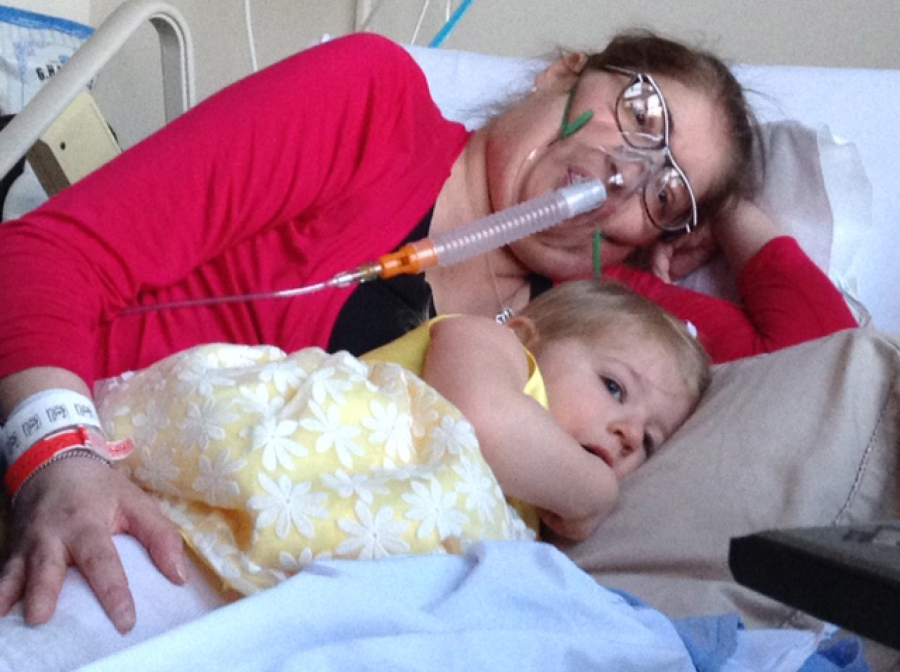Melissa Benoit’s lungs had been weakened by cystic fibrosis and ravaged by bacterial infections for three years. Then, last February, a bout of swine flu sent her spiraling toward death.
By April, she gasped for air with every breath. She had coughing fits so intense her ribs fractured. Her lungs were as hard as a football and filled with pus, mucous and blood. Benoit could barely walk to the bathroom, let alone play with her 2-year-old daughter, Olivia.
The bacterial infection had become resistant to the strongest antibiotics, and sepsis was shutting down her organs one by one, according to her doctors at Toronto General Hospital.
She was dying – and so were her chances of receiving a lung transplant that could save her life: Too sick, she was dropped from the transplant list.
Several times on that Sunday in late April, doctors brought family members in to say goodbye to the then-32-year-old mother.
“We had reached the end of the road,” said Shaf Keshavjee, one of three surgeons attending Benoit. “There was nothing we could do to keep her alive.”
Quietly, though, her team of doctors had been mulling a procedure that could extend her life but had never been tried.
They could remove both lungs entirely and let machines do the work. If everything went right, the devices could keep her alive until donor lungs became available.
The machines they wanted to use had served only as a crutch for people with lung disease. The doctors didn’t know whether they could work long-term, or whether Benoit would succumb to infection or other complications from the tubes running in and out of her body. At that point, they didn’t even know when donor lungs might become available.
What they did know was that if they did nothing, Benoit would be dead by morning.
So they went to the family and explained the risky procedure.
“The family understood the risks and explained that Melissa had often told them she would want to try everything possible to live for her husband, Chris, and two-year-old daughter, Olivia,” the hospital said later in a news release.
Chris Benoit said in that news release that “things were so bad for so long, we needed something to go right, and this new procedure was the first piece of good news in a long time. We needed this chance.”
In a nine-hour procedure in late April, doctors removed Melissa Benoit’s lungs, and she was placed on “the most sophisticated life support possible for her heart and lungs,” according to the hospital.
Doctors detailed the procedure in a paper published in November in the Journal of Thoracic and Cardiovascular Surgery. They shared the story of the last-ditch procedure at a news conference Wednesday.
A small, portable artificial lung known as a Novalung was connected to her heart, oxygenating her blood and removing carbon dioxide. Another device helped her heart circulate the oxygen-rich blood throughout her body.
And with that, the procedure was no longer theoretical. Doctors put Benoit in a medically induced coma and rolled her into intensive care.
Keshavjee, the surgeon, told The Washington Post this week that doctors saw positive signs almost immediately, though that was the most nerve-racking time for him.
“Once we took the lungs out and she got connected, literally within 20 minutes, we were able to remove all the blood-pressure-supporting drugs,” he recalled. “That told us that the concept is right. She’s not going to die tonight, but we’re not home free. Now can we keep this state until we get lungs?”
They waited for nearly a week – either for lungs to become available or for complications to arise.
The lungs came first.
The transplant was a success – and a short time later, Benoit opened her eyes.
“They brought me back from death,” Benoit told The Post.
She still faces hurdles as a lung transplant recipient, doctors said.
She spent months walking on treadmills and lifting weights to build her strength, she said. The physical therapy continues, but the cane and the walker are gone.
More and more, she can keep up with her toddler. Most of Olivia’s memories were of her mother getting weaker and weaker, or “sleeping,” as the child calls her mom’s weeks in a coma.
Their last holiday before the procedure was Easter. They hid eggs up and down the hall for the holiday, and Olivia darted around collecting them. Benoit, on a high dose of oxygen, could barely muster the energy to get out of bed.
“Now we’re able to do things I haven’t been able to do for a very long time,” she said. “I play with her. We go out. Last week, we just went to the aquarium for the very first time.”




